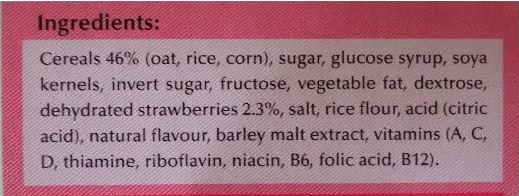When it comes to healthy eating, fresh is best and the less packaging there is, the more likely that food is to be healthy. There are though some healthy ‘packaged’ foods – you just have to know how to pick them! Being able to understand (not just read) a nutritional label will help arm you with the facts to determine if you are prepared to put that food into your body. Here are some of the things you need to look out for.
Ingredient Lists
The ingredients that go into making a food need to be listed on the packet. One little loop-hole that I find particularly annoying is that if an ingredient makes up less than 5% of the food, it doesn’t have to be listed. The only exception here is allergens or additives – they need to be listed not matter the quantity. When you are looking at the ingredients, they will be listed in descending order based on the percentage of inclusion. In this example, cereal grains make up the largest percentage, followed by sugar, with vitamins as the smallest inclusion.

When looking through ingredient lists, if you don’t recognise it as a ‘food’ (or it sounds more like it should belong in a science laboratory), best leave that on the shelf.
Comparing foods
When looking at nutritional tables and comparing foods, it’s always a good idea to make sure you use the ‘per 100g’ column. This makes sure you are comparing ‘apples with apples’ as the serving size will more than likely differ from product to product.
Fat
Looking at fat content is important, however the more important thing to assess the fat type. We’ve come a long was from thinking that all fat is bad, in fact, we need some fats for healthy hormone production, glowing skin and for our brains to work properly. The main thing you should check is the amount of saturated fats as they cause a rise in blood cholesterol levels. Try to make sure that the amount of saturated fat per 100g is no more than 2-3g.
Polyunsaturated and monounsaturated fats are good for the heart, brain and our cells – you will find these things mostly in oils from nuts, seeds or olives. When it comes to trans fats, if these are found put this product back down! This is not something that you want in your body.
You may have also heard that ‘fat is flavour’ so many low fat, processed foods will be topped up with sugar, salt and other chemicals to make them ‘taste nice’. Here are some of the common marketing phrases that you may see bantered about when it comes to ‘fats’.
– Light or ‘lite’ – this doesn’t necessarily have anything to do with the fat or energy content (although it may). It can relate to texture, taste or consistency. In some instances, it will be a second version of a former product that has undergone a reduction in fat content to give people another choice. That being said, it’s always a good idea to check the label.
– Low fat – The overall fat content is low in these foods. When it comes to solid foods, the fat content must be less than 3% while in liquid foods this is 1.5%.
– Fat – free – These products must contain no more than 0.15% fat. Again, check the label to see if there has been any extra fillers added in or if the ingredients used to make this product actually contain fat. Things like grains (corn, wheat, rye, rice, oats etc) have really low fat contents to start with. If you are trying to lose weight, it’s important to look at the overall kilojoule content irrespective of where the energy is coming from (ie: fat, protein or carbs). Just because something is low fat, doesn’t necessarily mean that it isn’t providing you with more energy than you need.
Sugars and Carbs
Our bodies preferred fuel source for energy production is carbohydrates. Trying to completely avoid carbs and sugars is not only completely unnecessary, but can also be detrimental to your health, wellbeing and energy levels. That being said, too much of a good thing is never useful either so getting the balance right should be your primary goal.
Carbohydrates can exist in 2 forms – complex and simple. Complex carbohydrates get broken down over a long period of time and help to keep our energy levels stable. Simple carbohydrates (sugars) get broken down much faster and give us an energy ‘hit’ almost instantly. You can work out the balance of complex: simple carbs in a food by looking at the nutritional label. Here’s how:
Subtract the amount of sugars (23g) from the total amount of carbohydrates (79g). The answer (56g) is the amount of complex carbohydrates found in the food, while the total number of ‘sugars’ is your simple carbohydrates
When it comes to making healthy choices, try not to go over anything that has more than 15% sugar (that is, 15g of sugar per 100g).
Cholesterol
Cholesterol is only found in animal products so if you see cholesterol free on a plant-based product like olive oil spread or grain-based crackers, your first thought should be ‘of course it is’.
Use this as a guide to make healthy choices especially if you are looking to reduce your cholesterol levels, however just because something doesn’t have ‘low or no cholesterol’ written on it, doesn’t mean that it contains cholesterol.
While it would be nice to have the time to always make everything from scratch, the reality of living a busy life is that it doesn’t always happen. Being able to make healthy, informed choices means you will be able to make better choices and while it may take you a few extra minutes when you’re in the supermarket initially, once you know the brands to go for you’ll become super speedy!
